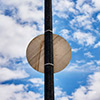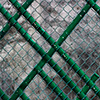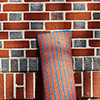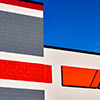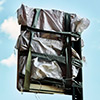
The city, however, does not tell its past, but contains it
like the lines of a hand, written in the corners of the streets,
the gratings of the windows, the banisters of the steps,
the antennae of the lightning rods, the poles of the flags,
every segment marked in turn with scratches, indentations,
scrolls.Italo Calvino, Invisible Cities
Jason Falchook’s new exhibition, Indivisible from the Sheen of Plastic, charts familiar territory for those familiar with his work. We see the same insistence on the surfaces of city-scapes, surfaces that are frequently overlooked, but are hiding in plain sight/site. These are places that we walk by everyday without seeing; their ubiquity rendering them invisible.
Much like Calvino’s observation from Invisible Cities, Falchook’s images lay bare the fact that history records itself as a series of accretions and excavations. Taking the time to look leads to taking time to remember, to recollect, to imagine, and—crucially—to reimagine. Each of Calvino’s 13 imagined cities is, in fact, Venice. But it’s not the Venice you read about in the guidebooks. Likewise, Falchook’s images are identifiably Brooklyn, mostly from a short radius in Bushwick where he lives, works, and walks. Even though they fulfill the documentary purpose of recording a particular place in a particular time, they function more as a kind of reliquary. They contain memories, dreams, and desires. Even though you never see humans in his photographs, you see their traces everywhere.
A sign is still a sign if its message is obscured, covered, or shown from the back. What the sign says—its putative “message” is less important than the fact that it is, in fact, a sign: a metal plate affixed to a metal pole, anchored in a concrete boundary, the curb, that separates the street (cars) from the sidewalk (people). The fence that you see every day, look at it again. What do you see? Looking is reading in a different measure. If you look long enough, what you thought you were seeing changes. You’re not so much looking at a photograph, you’re looking through the lens, as if you were there behind the camera. Falchook’s work is generous and inclusive in this way. You think, “Yes, I’ve seen these places, too.” And after you’ve spent enough time with his images (and your after-images), you really do see your own spaces in new, mysterious, and often beautiful ways.
-- Casey Smith

